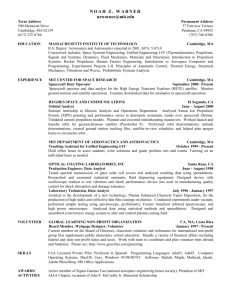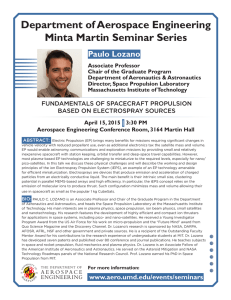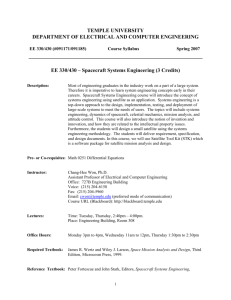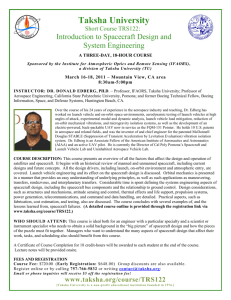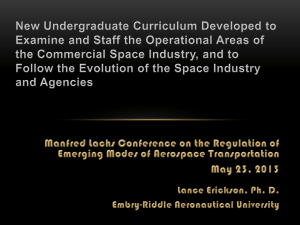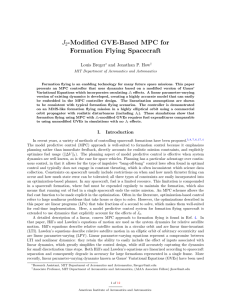TITLE Astronautics and Space Propulsion MODULE CODE 55
advertisement
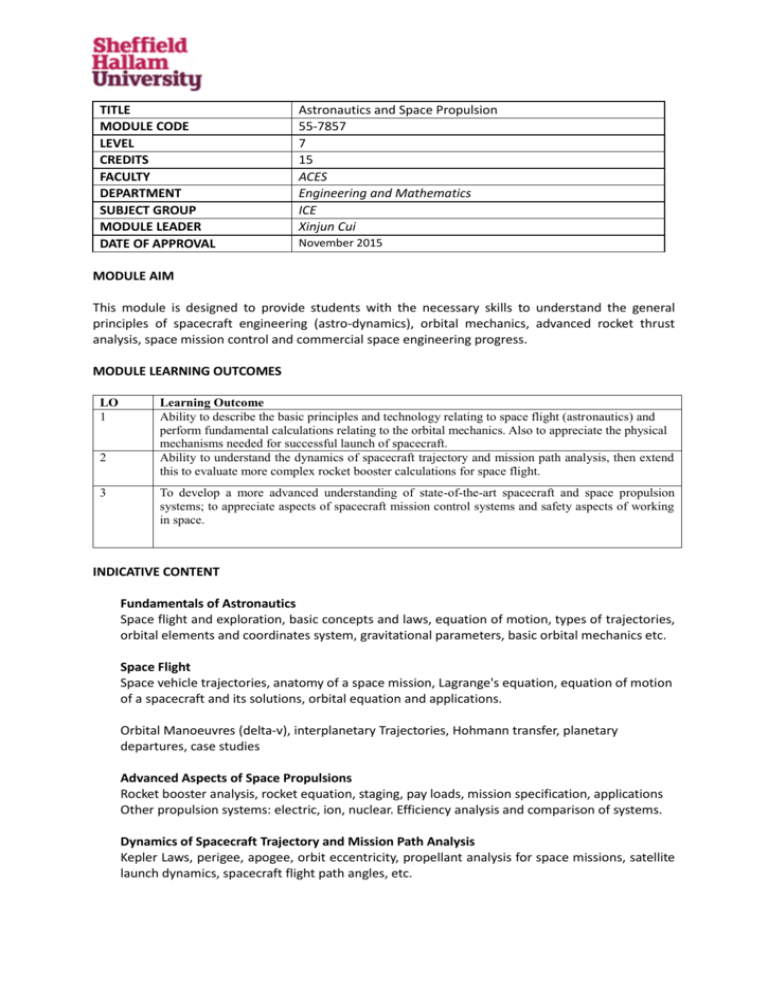
TITLE MODULE CODE LEVEL CREDITS FACULTY DEPARTMENT SUBJECT GROUP MODULE LEADER DATE OF APPROVAL Astronautics and Space Propulsion 55-7857 7 15 ACES Engineering and Mathematics ICE Xinjun Cui November 2015 MODULE AIM This module is designed to provide students with the necessary skills to understand the general principles of spacecraft engineering (astro-dynamics), orbital mechanics, advanced rocket thrust analysis, space mission control and commercial space engineering progress. MODULE LEARNING OUTCOMES LO 1 2 3 Learning Outcome Ability to describe the basic principles and technology relating to space flight (astronautics) and perform fundamental calculations relating to the orbital mechanics. Also to appreciate the physical mechanisms needed for successful launch of spacecraft. Ability to understand the dynamics of spacecraft trajectory and mission path analysis, then extend this to evaluate more complex rocket booster calculations for space flight. To develop a more advanced understanding of state-of-the-art spacecraft and space propulsion systems; to appreciate aspects of spacecraft mission control systems and safety aspects of working in space. INDICATIVE CONTENT Fundamentals of Astronautics Space flight and exploration, basic concepts and laws, equation of motion, types of trajectories, orbital elements and coordinates system, gravitational parameters, basic orbital mechanics etc. Space Flight Space vehicle trajectories, anatomy of a space mission, Lagrange's equation, equation of motion of a spacecraft and its solutions, orbital equation and applications. Orbital Manoeuvres (delta-v), interplanetary Trajectories, Hohmann transfer, planetary departures, case studies Advanced Aspects of Space Propulsions Rocket booster analysis, rocket equation, staging, pay loads, mission specification, applications Other propulsion systems: electric, ion, nuclear. Efficiency analysis and comparison of systems. Dynamics of Spacecraft Trajectory and Mission Path Analysis Kepler Laws, perigee, apogee, orbit eccentricity, propellant analysis for space missions, satellite launch dynamics, spacecraft flight path angles, etc. Elements of Spacecraft Systems: Re-Entry, Design, Control and Safety engineering Equation of motion for atmospheric entry, ballistic parameter, lifting entry, bow shock wave problems in the magnetosphere Tethering, fail safes, aerothermodynamics, materials specification for aerodynamic heating, atmosphere. International Space Mission Case Studies Examples from: NASA Space Shuttle, SERT, NSTAR, ARTEMIS, LISA PATHFINDER, Japan Space Agency, etc. LEARNING, TEACHING AND ASSESSMENT STRATEGY AND METHODS The module will be delivered through a combination of lectures and tutorials (worked examples, workshops and some electronic presentations of simulations in astronautics and space propulsion), together with, industrial visits and guest lectures invited from industries at appropriate. The complete lecture notes will be available via Blackboard. Further directed study will be supported by printed notes and guided reading. ASSESSMENT DESCRIPTION Coursework (30% of the module mark) will consist of a substantive astronautical analysis assignment set out around the middle period of module for the students to apply and develop their understanding in spacecraft flight dynamics and systems, with the support of appropriate computing simulations. An unseen 3 hour exam will contribute 70% of the overall mark for the module. Questions will span the entire modules. ASSESSMENT PATTERN - TASK INFORMATION (STANDARD ASSESSMENT MODEL) Task No.* 1 2 Description of Assessment Task Coursework Exam Task Weighting % 30 70 Word Count or Exam Duration ** 2500 3 hrs Subtasks Y/N+ IMR^ Y/N Final Task Y/N Y N N N N Y ANY ADDITIONAL REQUIREMENTS FOR THIS MODULE Prior knowledge of propulsion systems (e.g. passing the Propulsion Systems and Aerodynamics module) and competence in engineering mathematics and engineering principles (e.g. successfully completing levels 4-6 of the MEng Aerospace Engineering course, either route) FEEDBACK TO STUDENTS Students will receive feedback on their performance in the following ways Feedback will be given during tutorial/seminar sessions where the students will have the opportunity to work through example problems, ask questions and will be encouraged to reflect on their experience. Feedback on assignments will be given in written format normally within 3 weeks of an assignment being submitted LEARNING RESOURCES FOR THIS MODULE (INCLUDING READING LISTS) Lecture and tutorial notes will be available on the university's virtual learning environment system (Blackboard). Students should also take their own notes in lectures and tutorials and are encouraged to develop their understanding of the subject by reading recommended texts that will be available from the University library. Reading list ANDERSON, J. D. (2012 Introduction to flight (Vol. 199). Boston: McGraw-Hill. Print- ISBN: 9789814636186 BAKER (20111) Space shuttle manual, Haynes, Print-ISBN: 9781844258666 CURTIS, H. (2013). Orbital mechanics for engineering students. Butterworth-Heinemann. E-Book-ISBN: 9780080977485 EHRICKE, K. A. (1962). Space Flight, Volume II. Dynamics. D. Van Nostrand Company. Royal Aeronautical Society (2015) RAeS Spacecraft http://aerosociety.com/About-Us/specgroups/space (Astronautics) Working Group [on-line] SELLERS, J. J., Astore, W. J., Giffen, R. B., & Larson, W. J. (2000).Understanding space: an introduction to astronautics. Primis. Print-ISBN: 9780070570276 TURNER, M. J. (2009). Rocket and spacecraft propulsion: principles, practice and new developments. Springer Science & Business Media. E-Book-ISBN: 9783540692027 WALTER, U. (2012). Astronautics: the physics of space flight. John Wiley & Sons. Print- ISBN: 9783527410354 MODULE STUDY HOURS (KEY INFORMATION SET) Module Study Hours - Breakdown of Hours by Type Scheduled Learning and Teaching Activity type* Hours by type KIS category Lecture 27 Scheduled L&T Practical classes and workshops 9 Scheduled L&T Scheduled Learning and Teaching Activities sub-total 36 Guided Independent Study 114 Total Number of Study Hours (based on 10 hours per credit) 150 Independent
